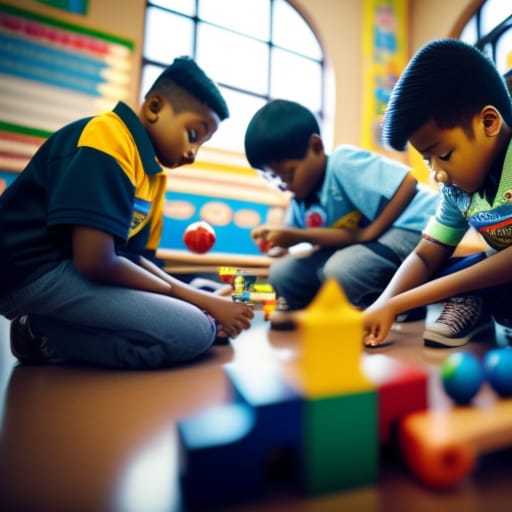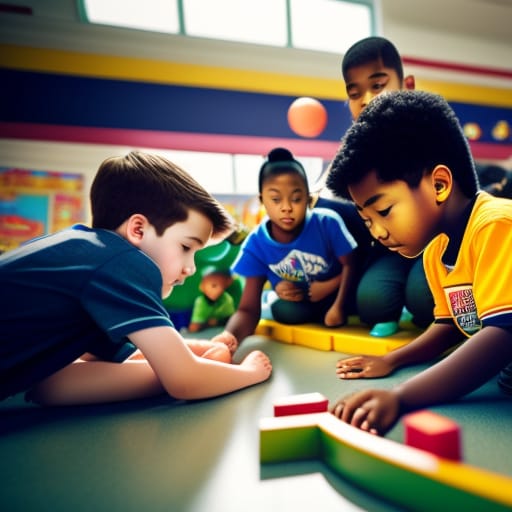Physics science toys are a great way for children and adults alike to learn about scientific concepts like magnetism, gravity, motion, energy, and more while having fun. This guide will explore the wide world of physics toys, and their benefits, and provide recommendations on the top toys to try.

What Are Physics Science Toys?
Physics science toys use principles of physics like gravity, electromagnetism, kinetics, and optics to demonstrate scientific concepts in an engaging, hands-on way. They allow kids to see physics in action, instead of just reading about it in books.
From classic toys like Newton’s cradle and the gyroscope to more modern toys like robotics kits and virtual reality headsets, physics toys make science come alive through playful experiments and activities. They nurture curiosity, problem-solving skills, and an early interest in STEM fields.
Benefits of Physics Science Toys
Physics toys provide many benefits beyond just being fun:
- Educational value – They teach core concepts like energy, electricity, light, motion, and magnetism.
- Hands-on learning – Kids can actively explore concepts rather than passively reading.
- Creativity & imagination – Open-ended play fosters innovation.
- Problem-solving skills – Toys present challenges to construct, build, and design.
- Collaboration – Kids can work together to build Rube Goldberg machines.
- Real-world connections – Toys demonstrate scientific principles used in the real world.
- Interest in STEM – Toys spark an early interest in science and math.
Types of Physics Science Toys
There are many types of educational physics toys that demonstrate different concepts:
Classic Mechanical Toys
- Newton’s cradle – steel balls collide and transfer energy
- Pendulum toys – demonstrate laws of motion
- Gyroscopes – illustrate angles and balance
Magnetism Toys
- Magnetic wand toys – explore magnetic fields and forces
- Magnetic levitation toys – objects float due to magnetic repulsion
- Ferrofluid toys – magnetically controlled liquid
Motion Toys
- Inclined planes – show the effects of gravity and friction
- Pulleys – change the direction of applied force
- Gears – transfer rotational force
Light Toys
- Kaleidoscopes – reflection and symmetry
- Prisms – split light into spectrum of colors
- Periscopes – use mirrors to look around corners
Electricity & Circuitry Toys
- Snap circuits – build working circuits with components
- Conductive dough – mold dough circuits to power lights
- Makey Makey – turn everyday objects into touchpads
Construction Toys
- Marble runs – creative freeform buildings
- Rube Goldberg machines – chain reaction contraptions
- Robotics kits – programmable bots
Recommended Top Physics Science Toys
Here are my top picks for the best educational physics toys for all ages:
Best Overall: Robotics Kits
Robotics kits allow kids to build and program real robots and machines. They teach coding, engineering, electronics, and Physics concepts.
LEGO Mindstorms is the classic intro robotics kit for ages 10+, with drag-and-drop programming and sensors. FIRST Robotics kits are more advanced, for teens.
Best Classroom Toy: Magnetic Levitating Globe
This magnetic floating globe demonstrates diamagnetism and allows kids to explore geography and gravity. Spinning it looks magical!
Best Construction Toy: K’NEX
K’NEX building sets include rollercoasters, ferris wheels, cars, and more machines that incorporate physics concepts like energy, friction, gravity, and motion.
Best Outdoor Toy: STOMP Rockets
STOMP Rockets are powered by air pressure created by stomping on a launch pad. Kids can experiment with rocket fin shapes, angles, weight, and height.
Best Screen-Free: Snap Circuits
Snap Circuits teach electronics and circuitry with different components that snap together to build working circuits, radios, burglar alarms, and more.
Best Educational Toy: Gyroscope
Gyroscopes have a spinning disk that keeps itself balanced, demonstrating principles of angular momentum. These captivating toys seem to defy gravity!
Best for Toddlers: Wooden Ramp Toys
Ramps demonstrate forces and energy as balls roll down. Add pendulums, levers, pulleys, and gears to create kinetic sculptures.
Best Budget Toy: Slinky
Slinkys jiggle and slink their way downstairs in a mesmerizing coil. They provide intro physics lessons on waves, tension, and energy.

Choosing the Right Physics Toy
Keep these tips in mind when choosing a physics toy:
- Age range – Check suggested ages and complexity levels.
- Interests – Find a toy that fits the child’s interests – building, magnets, robots, etc.
- Skill level – Start simple, then gradually increase the challenge as skills develop.
- Budget – Set a reasonable budget and buy quality for durability.
- Supervision – Look for toys labeled non-toxic if young kids will mouth them.
- Reviews – Read parent feedback online about educational value.
Fun Ideas and Activities with Physics Toys
- Set up ramps, tunnels, and pendulums for marbles to roll through and observe motion.
- Build elaborate Rube Goldberg machines with friends using balls, dominoes, ramps, and levers.
- Make a roller coaster for a marble out of foam pipe insulation. Time the marble runs.
- Launch stomp rockets to see how angle, weight, and force affect flight. Record the results in a table.
- Use a motor to build a Ferris wheel, merry-go-round, or carousel to demonstrate centripetal force and circular motion.
- Build mazes and contraptions for a programmable robot or Sphero to navigate around and through.
- Follow tutorials to build real electronic devices like radios or guitars from a Snap Circuits kit.
The possibilities for fun Physics exploration are endless! Encourage kids to brainstorm and experiment with their own ideas too. The open-ended play will exercise their imagination and problem-solving skills.

The Importance of Play in Learning
Free play with toys allows children to learn concepts naturally at their own pace. Physics toys introduce STEM principles through hands-on play rather than formal instruction.
Play builds a lifelong love of learning, creativity, confidence, and cognitive abilities. So put away the worksheets, and bring on the science toys! Learning physics doesn’t have to be hard – playing is learning.
“Play is our brain’s favorite way to learn.” – Diane Ackerman
Fostering an Early Interest in STEM
Getting kids engaged in science and engineering at an early age helps set them up for success.
Physics toys provide the building blocks for later STEM learning by nurturing curiosity, problem-solving skills, and passion for how things work.
Hands-on exposure to concepts like forces, motion, magnetism, and energy gets kids excited about the beauty of math and science. Nurture your future genius – start with physics toys today!
Frequently Asked Questions
What physics concepts do science toys teach?
Science toys teach core physics concepts like gravity, magnetism, motion, energy, electricity, light, friction, forces, balance, and more through hands-on play. Kids gain an intuitive understanding by seeing the principles in action.
What are the best physics toys for preschoolers?
The best preschool physics toys include ramps, marble runs, building blocks, pendulum toys, rolling balls, levers, pulleys, etc. Look for toys that let them explore cause-and-effect relationships through basic construction play.
What are the best physics toys for elementary school kids?
Bigger kids will enjoy more complex building toys like K’NEX, marble runs, or Rube Goldberg machines, plus toys that teach gravity, kinetics, and energy like pinball machines or Fischertechnik kits. Also introduce circuitry toys like Snap Circuits or littleBits.
What are the best physics toys for middle schoolers?
Middle schoolers will benefit from more advanced physics toys like programmable robotics kits that teach coding and engineering, 3D printing pens and kits, drones to explore aerodynamics, VR headsets, and advanced circuitry kits to build radios, robots, or guitars.
Are physics toys just for boys?
Absolutely not! Physics toys are equally enriching for girls and important for closing the gender gap in STEM interests. Opt for gender-neutral colors and marketing if possible. Focus on interest rather than gender when choosing toys to encourage physics exploration for ALL kids.